HEALTH CARE MANAGEMENT
Sheep and Goat
Good hygiene and preventive treatments are vital aspects of good production.
The signs of good health include general alertness, good movement, absence of lameness, good uniform fleece and absence of rubbing, active feeding and rumination and no wounds, abscesses or injuries.
General Hygiene
- Proper cleaning of handling areas and houses.
- During housing, proper attention should be given to ventilation.
Disinfection
- General disinfection of all the equipment used for routine procedures and treatment.
- Thorough disinfection is required during the lambing season of housed sheep.
Preventive and other treatments
Treatments involve vaccination, dosing (drenching), spraying or dipping foot bathing and foot treatment. Programme of treatment is usually taken up following consultation with veterinary surgeon.
Control of Parasites
- The important parasites of sheep include stomach worms, nodular worms, lung worms, liver flukes, ticks and lice.
- Phenothiazine, thiabendazole and tramisol are some of the products that may be used to control stomach and nodular worms.
- These may be alternated in use to avoid the development of resistant strains of parasites.
- Each year the ewe flock and rams should receive deworming medicines: two weeks before the breeding season.
- Ticks can be controlled by dipping or spraying with toxaphene, malathion or by dusting with rotenone.
Vaccination schedule for sheep
Disease | Age | Dose (ml) s/c | Booster | Interval | Season |
Food and mouth disease | Adult | 5 | Annual | Preferably winter/autumn | |
Rinderpest | Adult | 1 | 6months | Annual | Winter |
Black disease | Adult | 2 | Annual | All seasons | |
Lamb dysentery | Lamb | 2 | Annual | All seasons | |
Black quarter | Adult Lamb | 2 3 | Annual | All seasons preferably May/June | |
Enterotoxemia | Adult | 2.5-5 | 7-10 days | Annual | Lambing season |
Haemorrhagic septicemia | Adult | 2 | Annual | March/June | |
Sheep pox | Lamb sheep | 3 5 | Repeat at 6 months Repeat annually | December/March | |
Lung worm | Lamb 3 months age | 1000 larvae First dose | One month later 2000 larvae |
Source: Schultz, R.D. and cott, F.W. (1978). The veterinary clinics. North America, 8:755. W.B. Saunders Co.; Philadelphia, London, Toronto.
Vaccination schedule of goats
Disease | Age | Booster | Route and dose | Remark |
FMD | 6-8 wks | Repeat every 6-9 months | 1 ml s/c or i/m depending on the vaccine |
|
HS | 3-4 months | Repeat annually | 1 ml s/c | May/ June |
Sheep pox | 3-4 months |
| 1 ml s/c |
|
Tetanus | 3-4 months | Repeat at 6 months and then annually | 0.5-1 ml s/c or i/m |
|
Anthrax | 4-6 m | Repeat annually | 0.5 ml s/c at tail fold | In endemic areas only |
Enterotoxemia | 3-4 m | Repeat at 5 days and then annually | 2.5 ml s/c | First two doses before august |
PPR | 3 months | Repeat annually | 1 ml s/c | Do not give in pregnant animals |
COMMONLY OCCURING DISEASES IN SHEEP AND GOAT
| DISEASES | SYMPTOMS | HOW CONTACTED | TREATMENT AND PREVENTION |
| Acute viral pneumonia | Nasal discharge, frequent sneezing, coughing, diarrhea, symptoms subside within 7-10 days | Direct contact, nasal discharges | Use of antibiotics to prevent secondary bacterial infection, limited success with combined vaccine PI.3 & P. haemolytica |
| Peste des petes ruminantia (PPR) (pseudorinderpest) | High fever, oral necrosis, catarrh, nasal discharges and diarrhea. Within a week high mortality due to dehydration and respiratory problem. Mucopurulent discharge from nose. | Direct and indirect contacts, respiratory or nasal discharges | No effective treatment, control by Vaccination and quarantine, slaughter of sick and exposed goat, disinfections, prevent secondary infection. |
| Foot and mouth disease | Small lesions on tongue and mouth typical vesicles on dental pad, interdigital cleft with pronounced foot lesions, salivation, lameness, high rise in body temperature | Direct or indirect contact by material contaminated feed, beddings tools, fence, manure etc | Segregation and other sanitizing measures, vaccination in Feb/ March (polyvalent- FMD vaccine) |
| Contagious pustular dermatitis (CPD) or orf or contagious ecthyma | Swelling as red spots at mouth commisures, lips and nostrils. Vesicles followed by pustules forming scabs loss of body condition, death due to starvation and pneumonia secondary infection. | Direct or indirect contact by material contaminated feed, beddings tools, fence, manure etc | Isolation of sick animals, application of antiseptic cream on lesions. Annual vaccination of pregnant does, antibiotic administration. |
| Affected sheep show dullness, depression anorexia and pyrexia, salivation, mucopurulent nasal discharge, lachrymation | |||
| Maedi visna (dyspnea-wasting) | Weight loss, respiratory distress, circling and posterior peresis, lameness due to knee joint involvement. | Direct or indirect contact by material contaminated feed, beddings tools, fence, manure etc | Contaminated of affected goats selective culling, no to grazing, culling of reactors at 6 month interval |
| Viral entiritis | Lack of appetite, dyspnea, abdominal pain, blood stained faeces | Direct or indirect contact by material contaminated feed, beddings tools, fence, manure etc | No proper specific treatment, proper hygiene, vaccination |
| Scrapie | Excessive excitability, shivering of head and neck, restlessness, incoordination of gait followed by emaciation and impaired vision | – | No treatment, all the affected animals should be killed |
| Goat pox/ capri pox | Temp. 40-40.60C, blisters and pustules on various parts of body skin around mouth, nostrils, eye, ear, udder and teat are affected, discharges from eyes and nose | Inhalation, through broken skin, material contaminated with discharge | Antibiotic treatment for early healing, washing of lesions by H2O2 and apply antiseptic cream, isolation, vaccination |
| Blue tongue | Depression and sluggishness, high rise of temp, edema of muzzle, lips oral and nasal mucosae, excessive salivation, ulcers in oral mucosae, swelling of tongue bluish in look, animal off feed. Lameness due to coronitis and pain in hooves | Insect borne infectious disease, Culicoides midges | Destruction of midges breeding sites, isolation, smoking and spraying of insecticides. Use of antibiotic |
FMD
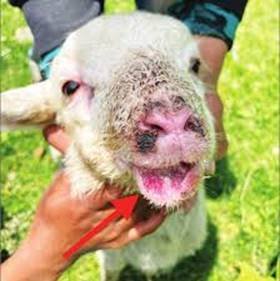
ORF
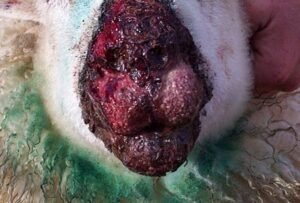
Fig 1: Contagious pustular dermatitis virus most commonly results in proliferative lesions following trauma of the lips/gums
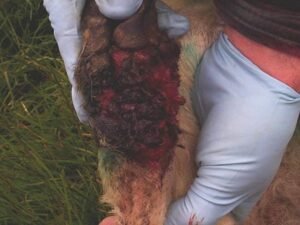
Fig 2: CPD virus and Dermatophilus congolensis may act together to produce large granulomatous masses extending 4 to 8 cms from the coronary band often referred to as “strawberry footrot”.
MAEDI/ VISNA:
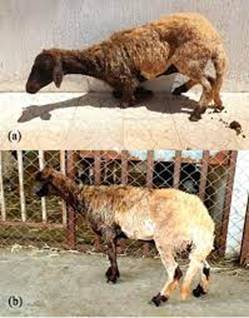
PPR
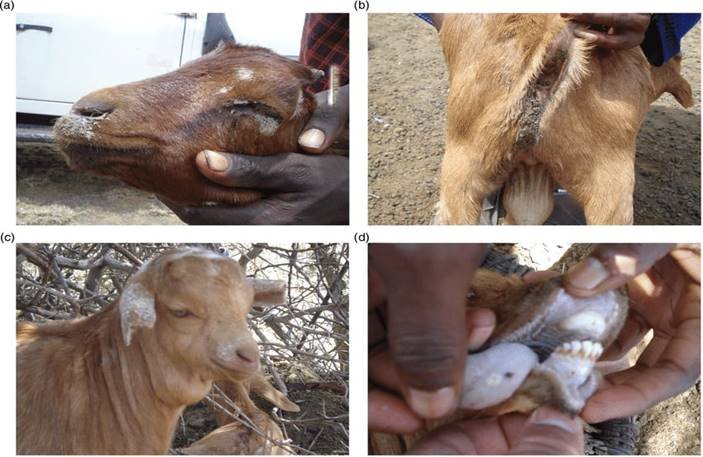
- A) oculonasal discharges and matting of eyelids
- B) diarrhea soiling the perineum
- C) submandibular edema
- D) sores and nodules on the gums and tongue
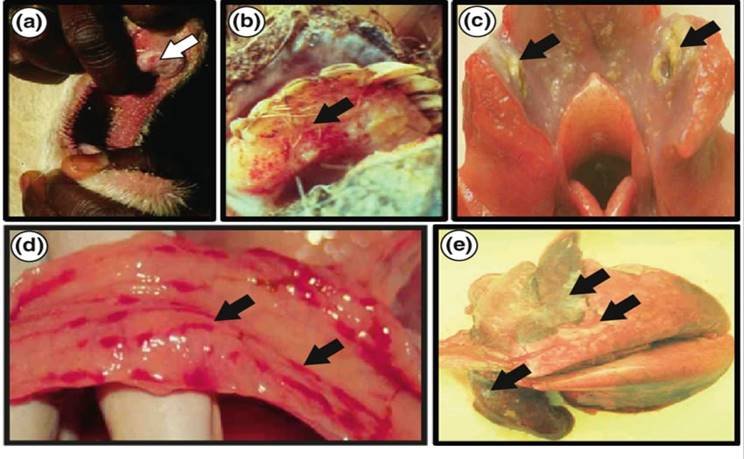
a.Necrotic lesions on dental pad;
b. lesions on gum and oral cavity;
c .oro-pharyngeal sections showing necrotic lesions on palatine tonsils and small fibrin deposits on the base of tongue;
d. zebra striping in large intestine and
e. consolidated lungs
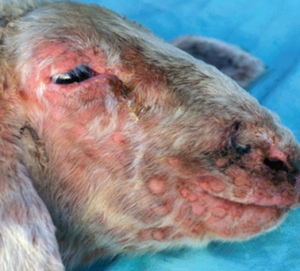
Sheep pox- Erythematous papules, nodules and plaques around mouth , nose and eyes
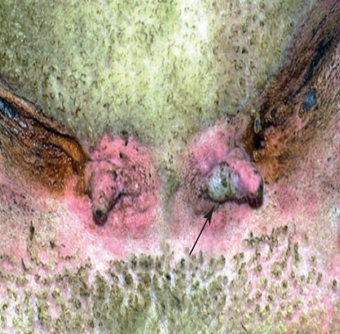
Sheep pox in sheep – vesicle on teat
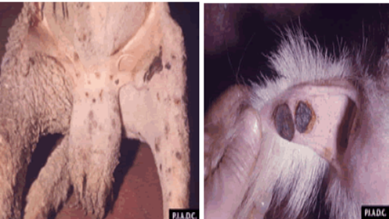
Goat pox – pock lesions at the base of the tail
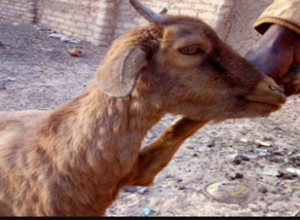
Goat pox
Blue tongue

Haemorrhage of the coronary band

Swollen cyanotic tongue
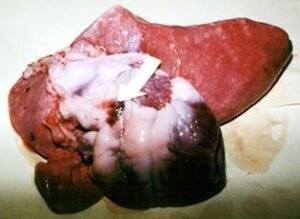
Haemorrhage at the base of the aorta
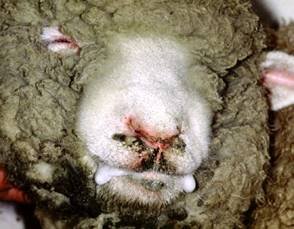
Edema of the muzzle and excessive salivation
BACTERIAL DISEASES
DISEASE | SYMPTOMS | ROUTE OF INFECTION | TREATMENT AND PREVENTION |
Black Quarter | Gas gangrene, death before 48 hours, high rise in temp, limping gait, septicemia | Contaminated food and water with blood; or by biting insects; wound infection | Sanitation, isolation, anti-BQ serum, annual vaccination by formal killed vaccine |
Hemorrhagic septicemia | High fever, swelling in neck egion, labored breathing, eyes swollen, enlarged tongue, off the feed. Difficult swallowing, death in 24 hours up to 70% | Fatigue from journey predisposing factors, direct contact, contaminated feed and water | Segregation, use of sulphanamides and antibiotics such as pencillins; vaccination. |
Atypical pneumonia or enzootic pnuemonia | Reduced appetite, chronic coughing, depression, dyspnea, dropping ears, mucopurulent nasal discharges, reduced weight gain, general unthriftyness, bronchitis and pleuritis | Direct contact, contaminated water and feed, ingestion and inhalation | Administration of sulphonamide antibiotics up to 3 days, vaccination 2 weeks before rain |
Johne’s disease | Gradual loss of body condition, pasty or loose faeces, thickening of mucosa of small and large intestines, emaciation, enlargement and paleness of mesenteric lymphnodes weakness. Normal appetite, mild but constant coughing weakness, rough coat, intermittent diarrhoea. | Contaminated feed and water | No effective treatment, isolation of suspected unthrifty animals, proper disinfection and vaccination |
Pasteurellosis or pneumonic septicemia | Temp. 103-1060 F, dullness, difficult respiration, muscular tremors. Discharge from eyes and nose. Death in few days to 3 weeks. Salivation, continuous coughing, localized edema at neck and or brisket parts | Direct and indirect contact in transportation and over-crowding, Aerosol route. | Administration of sulphonamide antibiotics, vaccination with vaccine of most serotypes |
Enterotoxemia or pulpy kidney disease | Dullness, oral frothing, jaws movement abdominal pain, staggering gait, chewing of dirt, irregular breathing, twitching of muscles, convulsions, grinding teeth, coma and death within 1-4 hours. Constipation followed by blackish diarrhea, blood in faeces in last stage due to intestinal haemorrhage. | Contaminated feed and water, discharges from affected animals | Vaccination before 2-4 weeks before kidding; again to new borns at 3-4 months age followed by booster dose after 15-20 days; use antiserum, repeat vaccination yearly; no treatment. |
Tetanus/lockjaw | Minor stiffness and difficult to move muscles become stiff and rigid, head and neck stretched, jaws become locked, difficult breathing, if falls on the ground legs are over extended. High alertness, sensitivity to noise continuous tonic centriction to muscles Asphyxia. | Contaminated soil, camel and horse dung, entrance through wounds from shearing, docking, castration etc. | Cleanliness, aseptic precaution in castration and docking, vaccination |
listeriosis | In nervous form: dullness, goes off feed, fever, walking in circle, nasal discharge, conjunctivitis, tongue protrudes, salivation. Abortion form: placentitis, still birth, abortions, death of new born, metritis; seepticemia, hepatitis, splemitis, phenumesia, pyrexia, fever and diarrhea | Contaminated pasture grass, feed, water, silage | Prevent stress, follow sanitation and hygiene to prevent contamination, use of antibiotics and sulphonamides use of attenuated vaccine. |
Foot rot | Lameness, painful swelling on foot between cleft, Rapid loss of body weight | Wet marshy and badly drained pastures, insanitary conditions of stalls, foot injury | Proper trimming of hooves, keep proper sanitation and hygiene, keeping floor dry, apply 10% chloramphenicol in 70% alcohol in foot, driving goats through foot bath containing 5% copper sulphate solution. |
Navel ill/joint ill or neonatal polyarthritis | Slight fever, lameness, one or more joint release greyish white pus. | Use of unclean tools, dirty pens, wet floor, badly drained pastures. | Colostrum feeding of young ones, proper disinfection of navel with iodine, general sanitation and hygiene in pens, streptopencillin in early stage effective. |
Wooden tongue (Actinobacillosis) | Wooden tongue, tongue become hard-unable to eat | Entry through wounds | Use of antibiotics |
JOHNE’S DISEASE

Enterotoxemia
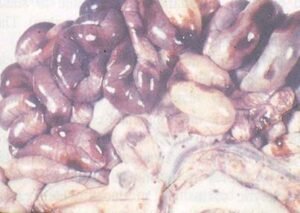
Enterotoxaemia- Dilated intestine showing a patchy congestion
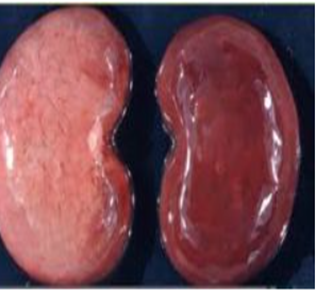
Pulpy kidney appearance
BACTERIAL-ABORTIONS
Brucellosis | Both goats and sheep are affected, abortion occurs in late pregnancy, before abortion animal is uneasy. Other symptoms are mastitis, synovitis and arthritis | Licking of aborted fetus, eating placenta, organisms enter through mouth, inhalation, conjunctival, even through skin | Isolation and give rest. Treatment is not effective. Single dose of Rev.1 vaccine, periodic testing and elimination. Burn fetus, placenta, bedding disinfect the place with 2% lysol |
Campylobacteriosis | Abortion in last 6 weeks of gestation, still birth, weak kid/lamb, metritis after abortion, few doe may die after abortion; those survive develop 2 years immunity. | Licking of aborted fetus, eating placenta, organisms enter through mouth, inhalation, conjunctival, even through skin. Contaminated feed and water through carriers | Isolation and rest. Vaccination by combined vaccine with chlamydia and campylobacter |
Salmonellosis | Abortion in last 7 weeks of gestation, still birth, metritis after abortion | Licking of aborted fetus, eating placenta, organisms enter through mouth, inhalation, conjunctival, even through skin. Contaminated feed and water through carriers | Isolation and rest. Proper disposal of placenta, fetus and contaminated litter by burying in quick lime, use antibiotics to decrease losses |
PARASITIC INFESTATIONS
Protozoan diseases |
|
|
|
Coccidiosis | Unformed faeces, loose motion, faeces mixed with blood, dehydration, loose body weight, rough hair coat, anaemia, low apetite, may have slight fever. | Contaminated feed and water, pasture with sporulated oocysts | Sulphamizathine 5 days per oral. Amprolium drenching for 3 days. Other drugs are nitrofurazones, sulmet course 4 days; bifuran avoid humid conditions, proper hygiene of sheds, sanitation. Avoid humid conditions, proper hygiene of sheds, sanitation |
Theileriosis | Pyrexia (104-1070F), anorexia, depression, anaemia, oedema under lower jaw, pregnant animal may abort. Swollen liver, persistent diarrhea, exhaustion, dehydration | Transmitted by ticks from sick to healthy animals | Course of Berenil alongwith quinine, antibiotics. Control of ticks; treatment is not satisfactory |
Helminthic diseases | |||
Trematodes |
|
|
|
Fascioliasis | Sick goat/sheep get isolated, irritation; off feed, weak, anaemic, edema under lower jaw, pregnant animal may abort. Swollen liver, persistent diarrhea, exhaustion, dehydration | Animals of 4 to 12 months age are more susceptible. Contaminated feed, water with snail (Limnaca) | Proper land drainage, use of CuSO4 for killing snails in ponds etc. |
Small liver fluke (Lancet fluke) | Low feed intake, keep standing, abdomen is distended and painful upon manipulation, death in few days. | Contaminated feed with metacercaria, snails and ants as first and secondary hosts | Use of Albendazole, Refoxanide as per vet advice. |
Nematodes Abomasal worms 1. Haemonchus contortus 2. Oestetagia circumcincta 3. Trichostrongylus axei | Diarrhea, soiling of hind quarters, bottle jaw, paleness of mucus membranes, inflammation of intestines, low feed intake, poor growth, weakness, unthriftness, mortality range 1 to 13% | Infective stage of eggs, larvae are eaten up by grazing animals in spring or rainy season | Prevent pasture contamination by eggs in monsoon kidding/ lambing season. Use of broad spectrum antihelminth seg., Fenbendazole, Albendazole, probenzimidazole, Livansole, Morental, Ivermectin. |
Cestodes-tapeworms | Loss of condition, unthriftiness | Infective stage of eggs, larvae are eaten up by grazing animals in spring or rainy season | Ploughing of grazing area and cross grazing with large animals. Dosing with Fenbendazole and niclosamide |
Verminous pnuemonia | Frequent coughing, retarded growth and loss of body weight. Nasal, eye discharges with difficult respiration and sometimes diarrhea in later stages | Infective stage of eggs, larvae are eaten up by grazing animals in spring or rainy season | Effective drugs are Fenbendazole, levamisole, Albendazole, Ivermectin; use of irradiated vaccine |
DEFICIENCY DISEASES
DISEASES | CAUSES | SYMPTOMS | TREATMENT/CONTROL |
Goitre | Lack of iodine in body, feed and water | Kids lambing die soon after birth, enlargement of thyroids below the angle of jaw bone | Supply amount of iodized salt to breeding stock in gestation period |
Pine | Cobalt deficiency | Loss of appetite and condition, loss of body weight, progressive anemia, coma and death | Mix cobalt sulphate in feed/mineral mixture. Give vit B12 inj. Supply CuSO4; cobalt chloride+Ferrous sulphate mix in 1:1:4 ratio @ 1 gm per doe/day upto 5 days |
Sodium, potassium chlorine | Lack of minerals in soil, feeds/fodders, water and blood serum | Anorexia, conditions like edema, progressive loss of condition, low feed intake, low growth rate, low productivity and fertility. | Balancing the diet, add sufficient minerals as per requirements |
Calcium, Phosphorus | Lack of minerals in soil, feeds/fodders, water and blood serum | Hypocalcemia, poor milk yield, poor growth, rickets, pica, depression, weakness, unable to stand. | Supply enough vit D through additions maintain Ca: P ratio 2:1 in feed |
Copper, cobalt iron, zinc, magnesium | Lack of minerals in soil, feeds/fodders, water and blood serum | Anaemia, emaciation, birth of weak young ones, slow growth, poor development, low production sway back and paralytic, pine syndrome, hypomagnecaemia | Balancing the ration, supply supplevit, min. mix |
Manganese | Lack of minerals in soil, feeds/fodders, water and blood serum | Swollen joints, stiff gait, poor fertility | Balancing the ration, supply supplevit, min. mix |
VITAMIN DEFICIENCY DISEASES
Vit.A | Lack of green feeds | Opacity cornea, weakness, retarded growth, lowered resistance; tests growth retarded, placental degeneration in female causes still birth or abortion, blindness | Vit. A supplement inj. Of aquous stabilized vit.A @ 400-I. U per kg body weight; feeding green. |
Vit B1 | Faulty diets | Nervous symptoms, cerebro-cortico necrosis anorexia, clamping of jaw, ruminal stasis, weakness | Balanced diet, vit. Supplement, Balanced diet, vit. Supplement, injection of thiamine or B complex in early stage effective |
Vit D | Poor sunlight, strict prolonged confinement in stalls | Weakness, impaired vision, stiff movement, stretching of head and limbs, excessive salivation, aimless movement developing convulsions. In last stage animal falls on side with legs holding high and kicking violently and then death, weak bones, rickets, poor growth and development | Feeding sun dried hay; vit. D supplement in ration |
ADDITIONAL INFORMATION
DETERMINING THE AGE OF GOATS
By just looking at the lower jaw of the goat it will be easy to determine the age of the goat.
Goat is a ruminant and does not have any incisor teeth in the upper jaw but posses’ hard pad on the top while the lower jaw has eight incisors front teeth. The goats have toward the back of mouth large teeth called molars which help the goat in chewing the grass.
First year of the kid | The front teeth are small and sharp in goats | with less than one year age. |
Second yearling | The center pair of teeth fall out and are replaced by two permanent teeth. |
Third year | Two more large front teeth appear on the side of the centre pair. |
Fourth year | Six permanent teeth appear. |
Fifth year | At this age eight permanent teeth appear in the front of lower jaw |
IMPORTANT INFORMATION ABOUT THE GOAT
Birth weight of kid | 0.94 kg Black Bengal 3.54 kg- Jamunapari |
Adult body weight of Indian goats | 19-40 kg |
Body temperature | 39-40.50C |
Age at puberty | 4-5 months |
Breeding season | In tropics (all year round), in Temperate (sept to Feb) |
Duration estrus | 12-48 hrs |
Gestation period | 146-154 days |
Average milk production | 800 gms per day per animal for 150 days |
Characteristic | Sheep | Goat |
A. PHYSICAL CHARACTERISTICS | ||
Tail | Generally long, hanging, hairy, broad | Short, thin and upright |
Back and withers | Round & well fleshed | Sharp, little flesh |
Thorax | Barrel shaped | Flattened laterally |
Flesh | Pale red and fine in structure | Dark red and coarse with goaty odour. Sticky subcutaneous tissue which may have adherent goat hairs |
General appearance | Fatty, mostly roundish type | Taller, thinner and more angular |
Body covering | Wool, hairy wool and hair | Hair |
Presence of bear | No bear or an odoriferous tail glands | Beared and strongly odoriferous tail glands in males |
Nature of horns | Mostly homonymous | Heteronymous |
B. REPRODUCTIVE BEHAVIOUR | ||
Onset of puberty | 4-12 months | 4-8 months |
Avg. age at first service | 12-18 months | 12-18 months |
Length of estrus cycle | 14-20 days | 7-24 days |
Duration of estrus | 24-48 hrs | 16-50 hours |
Gestation period | 150 days | 150 days |
Time of ovulation | 1-24 hrs before the end of estrus | 25-30 hrs after the onset of estrus |
Optimum of time of service | 18-24 hrs after the onset of estrus | 12-20 hrs after the onset of estrus |
Advisable time to breed after parturition | Usually in next winter | 80-90 days after parturition |
Breeding life span | 5-8 years | 6-10 years |
C. COMPARATIVE FEEDING BEHAVIOUR AND DIGESTIVE PHYSIOLOGY | ||
Activity | Walk shorter distances | Bipedal stance and walk longer |
Feeding pattern | Grazer, less selective | Browser, more selective |
Browse and tree leaves | Less relished, preference is on grazing | Relished and high preference |
Varieties in feeds | Prefer lesser | Prefer greater |
Taste sensation | Less discerning | More discerning |
Salivary secretion rate | moderate | Greater |
Recycling of urea in saliva | Lesser | Greater |
Dry matter intake |
|
|
—-for meat | 3% B.wt | 3% B.wt |
—-for lactation | 3% B.wt | 4-6% B.wt |
Digestive efficiency | Less efficient | Higher with coarse roughages |
Retention time | Shorter | Longer |
Water intake/ unit DM | Higher | Lower |
Rumen NH3 concentration | Lower | Higher |
Dehydration |
|
|
—-faeces | Relatively higher water loss | Less loss |
—-urine | Less concentrated | More concentrated |
